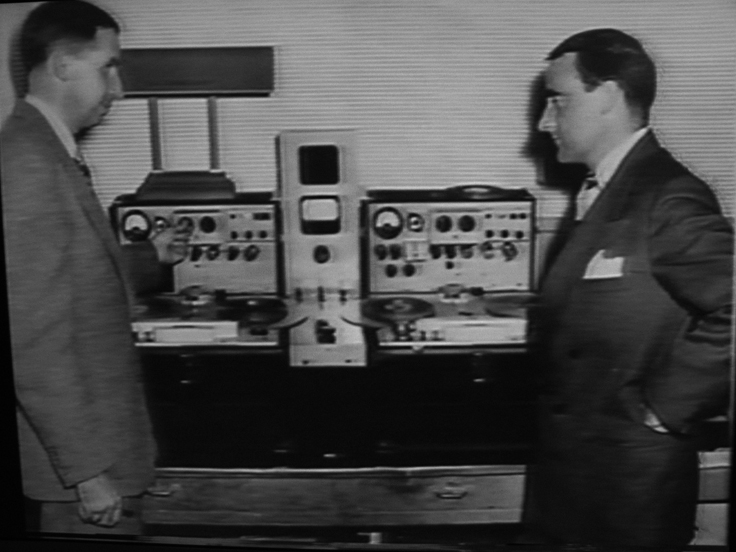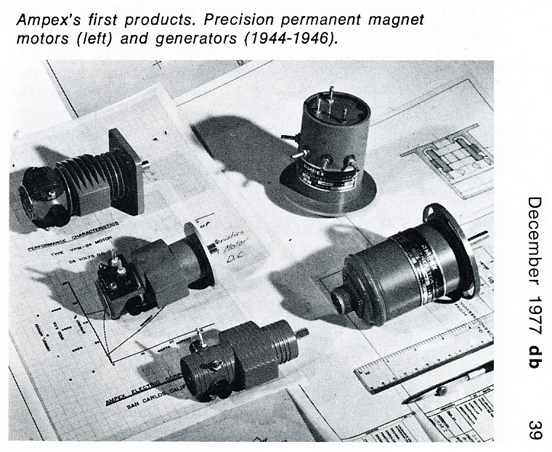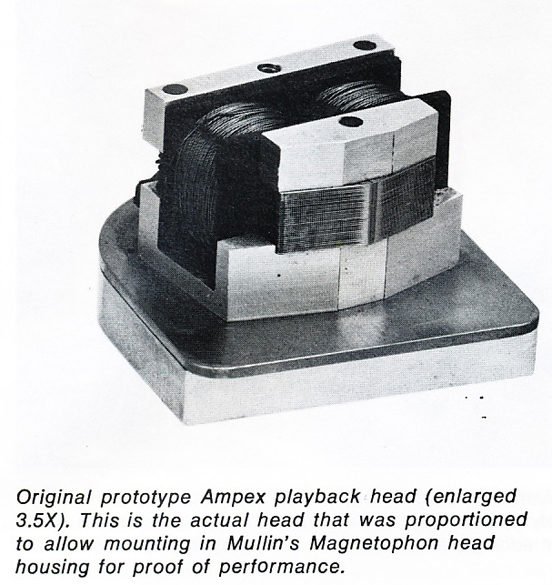Please take our Museum Survey • Survey Results • KXAN Austin Recording Museum Update

Ampex recorders are well known as some of the best built American professional reel tape recorders.
After WW II , John "Jack" T. Mullin, who was in the US Army Signal Corp, brought back to the US, 2 German Magnetaphon reel to reel magnetic tape recorders. Mullin took the 2 Magnetophons apart and shipped them back to the US in 18 boxes to comply with US war souvenir size requirements. Also included were 50 rolls of German magnetic tape.
In late 1945 as Mullin was returning from France, he shared the Magnetophon information with a friend, Col Richard Ranger. Ranger decided to go to Germany, research the information and build an American version of the Magnetophon.
When Mullin arrived at his home in San Francisco he was happy to find the 18 boxes had arrived safely. He decided to go to work with a friend William A. Palmer who had founded W.A. Palmer & Co., a film production company in San Francisco in 1936.
After tweaking the electronics and converting to US tubes the Magnetophons were used to support Palmer's film business. To their knowledge, this was the first time magnetic tape was used to record motion picture sound with the subsequent transfer to film.
A Palmer-Mullin demonstration of their magnetic recorders at the MGM studios in Hollywood in October, 1946, gained a great deal of attention when they provided a stunningly clear recording of a studio performance by the MGM Symphony Orchestra.
The first public demonstration of the recorders was to the local chapter of the Institute of Radio Engineers in San Francisco on May 16, 1946. Attending the demonstration was Harold Lindsey.
 Following a number of demonstrations, Mullin and Palmer attracted Bing Crosby's production folks. Crosby had been frustrated by the poor end quality of disc editing for his radio program. After Mullin and Palmer demonstrated the ability to not only capture a great recording, but also to be able to edit the content with noloss of quality, the Crosby folks decided to adopt the technology.
Following a number of demonstrations, Mullin and Palmer attracted Bing Crosby's production folks. Crosby had been frustrated by the poor end quality of disc editing for his radio program. After Mullin and Palmer demonstrated the ability to not only capture a great recording, but also to be able to edit the content with noloss of quality, the Crosby folks decided to adopt the technology.
Mullin eventually went to work for Crosby as his Chief Engineer, using the 2 Magnetophons and the 50 reels of German tape. He edited the Crosby shows splicing the various tape pieces together as Crosby and his producers directed. Crosby expressed concern regarding there being only 2 recorders and a limite d supply of tape.
d supply of tape.
In an article written for the db magazine published in December of 1977, Harold  Lindsay describes how excited he was about the magnetic recording technology Jack Mullin was demonstrating. Lindsay worked for the Dalmo Victor Company in California and a company named Ampex was building radar motors and generators for Dalmo to supply the US Navy. Given the lessening demand for the motors, Ampex was looking for another product to produce. Lindsay connected Alexander M. Poniatoff with Jack Mullin and Pontiatoff agreed that magnetic tape recorders was the way to go. He asked Lindsay to join Ampex and work with Myron Stolaroff to develop an Ampex tape recorder.
Lindsay describes how excited he was about the magnetic recording technology Jack Mullin was demonstrating. Lindsay worked for the Dalmo Victor Company in California and a company named Ampex was building radar motors and generators for Dalmo to supply the US Navy. Given the lessening demand for the motors, Ampex was looking for another product to produce. Lindsay connected Alexander M. Poniatoff with Jack Mullin and Pontiatoff agreed that magnetic tape recorders was the way to go. He asked Lindsay to join Ampex and work with Myron Stolaroff to develop an Ampex tape recorder.
At Jack Mullins suggestion, they began by developing a playback head. It proved to be superior to the one Mullin had on the original Magnetophons. Mullin had by this time agreed to record and edit for Bing Crosby and Bing Crosby Enterprises. As Mullin had committed to help Col. Richard Ranger with a recorder for Crosby, he could not share the electronics information with Ampex. However when Ranger's work failed to meet Crosby's expectations, Mullin encouraged Ampex to make a presentation.
Several interesting things occurred. As there was limited tape available from Mullin, Ampex was in a bind to have tape for testing. Luckily within a few weeks of each other, two tape manufacturers (Audio Devices and 3M) approached Ampex asking them to test their tape development. That solved the tape problem and the tape quality improved as did the development of the first Ampex recorder
 By the end of August 1947, the Ampex 200-A development was progressing well and the Crosby demonstration was scheduled. Just before the Crosby presentation, the Ampex 200-A record electronics developed a bug. The prototype was demonstrated anyway with playback only using Jack Mullin's tapes. It was lucky that in their development, Ampex had decided to match Mullin's Magnetophon tape speed (which = 30 ips), or the playback would not have been possible. In spite of there being a wide range of engineers who witnessed the demonstration, no one asked to see how the unit recorded.
By the end of August 1947, the Ampex 200-A development was progressing well and the Crosby demonstration was scheduled. Just before the Crosby presentation, the Ampex 200-A record electronics developed a bug. The prototype was demonstrated anyway with playback only using Jack Mullin's tapes. It was lucky that in their development, Ampex had decided to match Mullin's Magnetophon tape speed (which = 30 ips), or the playback would not have been possible. In spite of there being a wide range of engineers who witnessed the demonstration, no one asked to see how the unit recorded.
A few days after the demonstration, folks from Crosby Enterprises approached ampex with a request to distribute the recorder in eleven western states. An agreement was reached, contracts signed and immediately Croby's reps gave Ampex an order for twenty Ampex 200-A's. They were all for ABC in New York, Chicago and Hollywood.
As Ampex geared up to meet the demand they realized they had no funds and banks were not willing to loan to them given the new technology. However Lindsay states in his db article, an envelope arrived with a Hollywood postmark and inside was a check for $50,000 from Bing Crosby with no strings attached. Pretty amazing!
Ampex was named after the company's owner, A. M. Poniatoff , using his initials plus EX for excellence. Alexander Mathew Poniatoff was born in the Kazan District of Russia, about 400 miles east of Moscow, on March 25, 1892. His middle name is the first Christian name of his father, such designations being a Russian family tradition. Mathew Poniatoff was a successful businessman with a couple of dozen employees engaged in cutting timberland and producing firewood and parts for carriages and sleighs. (tonbandmuseum)
As 3M was working on developing magnetic recording tape and the products were tested, Mullin and the ABC folks decided the high end 3M tape was not as good as their low end product. Interestingly the iron oxide for the low quality tape was called 112 Raven Red which was also used for red barn paint.
The Ampex 200A was first demoed at Radio Center in Hollywood in October of 1947. It had cost $76,000 to develop. When the Ampex 200A was released for sale in April of 1948, it cost about $7,500. That was later reduced to $5,200. Ampex numbers 1 and 2 went to the Bing Crosby Show and were used to record his 27th performance of the 1947-1948 season. Weeks later ABC ordered 12 more recorders and record companies and broadcasters soon followed. Other sources indicate that ABC ordered 20 Ampex 200-As.
There were only 112 Ampex 200A's built.
The 200A ran at 30 ips and threading was called a "B" wind with the backing to the inside. This was later reversed. The over-engineered deck was built into a polished or stained wood console weighing 240 pounds.
We can hardily attest to the weight as it is most difficult to move around. The recorder was full track using 14 inch reels, 1/4 inch tape and was capable of a performance that was flat within .5 db from 30 hz to 15 kHz.
By May of 1949 most major recording studios had one. By June, 1950, NBC, CBS, Mutual, Dumont, etc. had at least one.
There are quotes with folks stating the Ampex 200-A was a wonderful sounding machine. Songs said to have been recorded on one of the Ampex 200A's included "(We're Gonna) ROCK AROUND THE CLOCK" ,Nat King Cole's "MONA LISA", "UNFORGETTABLE", Mario Lanza's "BE MY LOVE", Frank Sinatra's "YOUNG AT HEART" and Tennessee Ernie Ford's "SIXTEEN TONS"
Les Paul used his Ampex 200A and later the 300, 400 and 350 8 track to make his amazing records with Mary Ford. The 8 track, Ampex 350 based recorder produced by Ampex in 1957 was sold to Les Paul for $10,000. Les Paul loved the recorder, however commented that he never recorded a hit on it.
Our Ampex 200-A, Serial Number 33 was originally bought from Bing Crosby Enterprises, Inc. by Capitol Records in Los Angeles, California in 1948.
News clips detail some information regarding ABC and Capitol Records decisions to acquire the new technology. They include one in October 1947 saying that if magnetic tape was to air on radio really "materializes" ....reflecting a tone of reservation regarding the technology. And even in May of 1948 an article talks of capitol Records recording on both tape and a disc cutter to check the quality.
We have Capitol Records detail regarding the Ampex 200-A, #33's upgrade in 1949. This upgrade was to the Ampex 201 specs and involved the replacing of the original head cover and installing an Ampex 300 head cover and tape lifters. They also updated this Ampex 200A in 1954 and 1955.
Our Ampex 200A was subsequently acquired by Leo De Gar Kulka, known in the record and recording industry as "the Baron." Documents indicate he moved the Ampex 200A from Los Angeles to his Golden State studio in San Francisco around 1964. The Baron is remembered for his recordings of Frank Sinatra, Nat King Cole, Sonny Bono, among others. One story states Cher worked as the Baron's receptionist for awhile. He also produced the song "Tequila."
We were told that "the Baron" was always striving to keep up with the latest technology. The Ampex 200-A we acquired was upgraded to stereo using Inovonics amps. We initially were going to restore the recorder to its original state. However after learning more about the history of the unit, we have decided to work to acquire the original electronics, but will leave the unit as is for now.
During the early 1950s Ampex began marketing one- and two-track machines using ¼" tape. The line soon expanded into three- and four-track models using ½" tape. In the early 1950s Ampex moved to 934 Charter St. Redwood City, California. Ampex acquired Orradio Industries in 1959, which became the Ampex Magnetic Tape Division, headquartered in Opelika, Alabama. This made Ampex a manufacturer of both recorders and tape. By the end of that decade Ampex products were much in demand by top recording studios worldwide.
In 1952, Ampex was approached by movie producer Mike Todd, who wanted to develop a high fidelity movie sound system using sound magnetically recorded on the film. The result of this development was the Todd-AO motion picture system, which was first used in movies such as Oklahoma and The Robe. In 1960, the Academy of Motion Picture Arts and Sciences awarded Ampex an Oscar for technical achievement as a result of this development.
In 1966 Ampex built their first 16-track recorder, the model AG-1000, at the request of Mirasound Studios in New York City. In 1967 Ampex introduced a 16-track version of the MM 1000 which was the world's first 16-track professional tape recorder put into mass-production. Both used a 2 inch tape transport design adapted from the video recording division. The 16-track MM-1000 quickly became legendary for its tremendous flexibility, reliability and outstanding sound quality. This brought about the "golden age" of large format analog multitrack recorders which would last into the mid 1990s. MCI built the first 24-track recorder (using 2 inch tape) in 1968 which was installed at TTG Studios in Los Angeles. Later machines built by Ampex starting in 1969 would have as many as 24 tracks on 2 inch tape. In addition to this, the introduction of SMPTE time code allowed studios to run multiple machines in perfect synchronization, making the number of available tracks virtually unlimited.
By the late 1970s Ampex faced tough competition from Studer and Japanese manufacturers such as Otari and Sony (who also purchased the MCI brand in 1982.) In 1979 Ampex introduced their most advanced 24-track recorder, the model ATR-124. It was considered by many to be the finest machine of its type. The ATR-124 was very ruggedly constructed and had outstanding audio specifications which nearly rivaled the first digital recording machines. However, sales of the ATR-124 were slow due to the machine's very high price tag @ $62,500. Only 62 of the ATR-124 machines were sold. Ampex withdrew from the professional audio tape recorder market entirely in 1983.
Ampex Audio Recorders TimeLine
This information is based on ad and catalog information in our collection
1947 - 1948 Model 200A $7,200 > $5,200
1949 - Model 300 - $1,550
1950 - 1953 Series 400 $985 pic 2
1953 - Model 350 replaced 400, Ampex 450 (background music) name Ampex Corp adopted, 402C, 403C, 403P
1954 - Model 600, Speaker 620, Ampex prosumer Series "A" Stereo models A121, A122,& Mono models A111 & A112 Later called 960
1955 Ampex 350 and 600 Stereo has arrived
1956 Ampex 612 Ampex Models List Data recorders, S-5290 (basically a 601 mono set up for stereo and later called 601-2
1957 Ampex 8 channel Les Paul
1958 - 1965 AG 351 $1,675 601 & A112
1958 Ampex 351, Ampex 601-2 stereo, Ampex prosumer 960 Caprice,
1959 Ampex 601 and 601-2, Model 910 Universal "A", Ampex prosumer 960, 970
1960 Model 970 Model 351, Model 351-C
1961 Ampex The Fine Line Ampex prosumer 1200, 1250, 1260, 1270, Ampex 934, 936
1962 Redwood City facility ground breaking, Ampex 970, Ampex 960, 934 & Fine Line 1200
1963 Ampex moved into Redwood City facility, Ampex prosumer Fine Line F-44, Ampex 351-2P, Ampex 1250 & 2012 Speaker system, 601, 601-2 & PR-10, MX-35, 351 & 352
1964 MR-70, PR-10, F-44, 602-1 & 602-2, PR-10-2 - Ampex prosumer 2050, 2070, 2080, F-4460 & F-4470
1965 Ampex 602, 602-1, Ampex prosumer 860, 1070, 1160, 2070 duplicators, F-44, 4450, 4452, 4460, 2050, 2060, 2070, 1070,1050, 1080, 850, 961, 1161, 2161, Ampex Music Center
1966 AG-300, AG-350, solid state, PR-10, Ampex 600 Solid State, Ampex prosumer 860, 1160, 2060, 840
1967 AG-440 series, AG-500 series, AG-600, 602, 602-2, Ampex prosumer 850, 861, 1150, 1161, 2050, 2061, AV 770, 961, 1161, 2161, Ampex Music Center
1968 AG-500, AA-620 speaker system, AM-10, Ampex prosumer 755, 1455, 1461, 1461A reversing, 750, 761, 850, 861, 895, 1150, 1161, 2050, 2150, 2061
1969 AG-440B, AG-445, AG-500, AG-600 prosumer 755, 761, 861, 1461, 2161 $449, AM-10, 985, 1161, 750,
1970 AG-600, AG-500, AG440B, Ampex prosumer 755A, 767, 985A, 1455A, 1467, 2150, 2161,
1971 prosumer AX-300 $599.00, 2161, AX-50, 755A, Broadcast recorder ABR10 & ABR 15, AG440B, AM10 & MX 35
1972 - AG-600 Solid State
1973
1974 AG-440X MM-1100 AG-440C
1975 AG-440C MM-1100 ATR-700
1976 ATR-700 ATR-100 MM-1200
1977 MM-1200 AG-440C
1978 ATR-700 ATR-100 MM-1200
1979 ATR-100 ATR-124 MM-1200
1980 ATR-100, ATR-700 ATR-124
1981 MM-1100 ATR-124
1982 ATR 800 $5,450
1983 ATR-700 ATR-100 ATR-116 $48,500 ATR-124 $62,500 was the last Ampex reel tape recorder only 62 were made
Ampex Basic Concepts of Tape Recording
AES article about Ampex collection going to Stanford
AES article - Ampex 200A placed on display


